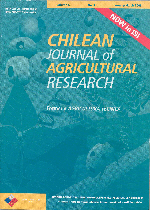
|
Agricultura Técnica
Instituto de Investigaciones Agropecuarias, INIA
ISSN: 0365-2807
EISSN: 0365-2807
Vol. 61, No. 1, 2001, pp. 82-88
|
 Bioline Code: at01009
Bioline Code: at01009
Full paper language: Spanish
Document type: Research Article
Document available free of charge
|
|
|
Agricultura Técnica, Vol. 61, No. 1, 2001, pp. 82-88
| en |
Biological Control of Ulex EuropaeusL.: Introduction to Chile of two Populations of the Moth Agonopterix Ulicetella(Stainton) (Lepidoptera: Oecophoridae)
Norambuena, Hernán M.; Escobar, Sergio S. & Rodríguez, Fernando A.
Abstract
Two strains of the moth
Agonopterix ulicetella
, a host-specific bioagent of the weed
Ulex europaeus
(gorse), collected in Hilo, Hawaii, and Plymouth, United Kingdom, were introduced
to Chile in 1996 and 1997. Bioagent selection considered the criteria suggested
by several biocontrol investigators. Once introduced to Chile, both strains
were subjected to quarantine, confirmation of specificity and breeding,
three essential protocols to develop a classical weed biocontrol program.
Both strains survived shipping, hemisphere change and produced new generations
in quarantine.
A. ulicetella
populations were authorized to be released under field conditions in Chile
in 1997 and 1998.
Keywords
weed biocontrol, biotic agents, beneficial insect, host-specific herbivores
|
| |
| pt |
Control Biologico de Ulex EuropaeusL.: Internacion a Chile de dos Poblaciones del Bioagente Agonopterix Ulicetella (Stainton) (Lepidoptera: Oecophoridae)
Norambuena, Hernán M.; Escobar, Sergio S. & Rodríguez, Fernando A.
|
| |
| es |
Norambuena, Hernán M.; Escobar, Sergio S. & Rodríguez, Fernando A.
Resumen
Durante 1996 y 1997, se colectaron en Hilo, Hawaii, EEUU,
y en Plymouth, Inglaterra, dos poblaciones del insecto
Agonopterix ulicetella
, un herbívoro específico de la maleza agrícola y forestal
Ulex europaeus
(espinillo). La selección de los bioagentes se realizó teniendo
en cuenta los criterios señalados por varios investigadores de control
biológico de malezas. Posterior a la introducción de dichas poblaciones
a Chile, se les sometió a las etapas de cuarentena, confirmación
de especificidad y crianza en laboratorio, protocolos esenciales para desarrollar
el método de control biológico clásico. Ambas poblaciones
sobrevivieron el transporte, el cambio de hemisferio y la cuarentena. Asimismo,
se obtuvieron nuevas generaciones de laboratorio de las poblaciones de Hilo
y Plymouth, lo cual permitió que se autorizara la liberación de
A. ulicetella
en Chile, en 1997 y 1998.
Palabras-clave
control biológico de malezas, bioagentes, insectos benéficos, herbívoros específicos
|
| |
© Copyright 2001 - Instituto de Investigaciones Agropecuarias, INIA (Chile)
Alternative site location: http://www.inia.cl/at/agritec.htm
|
|
